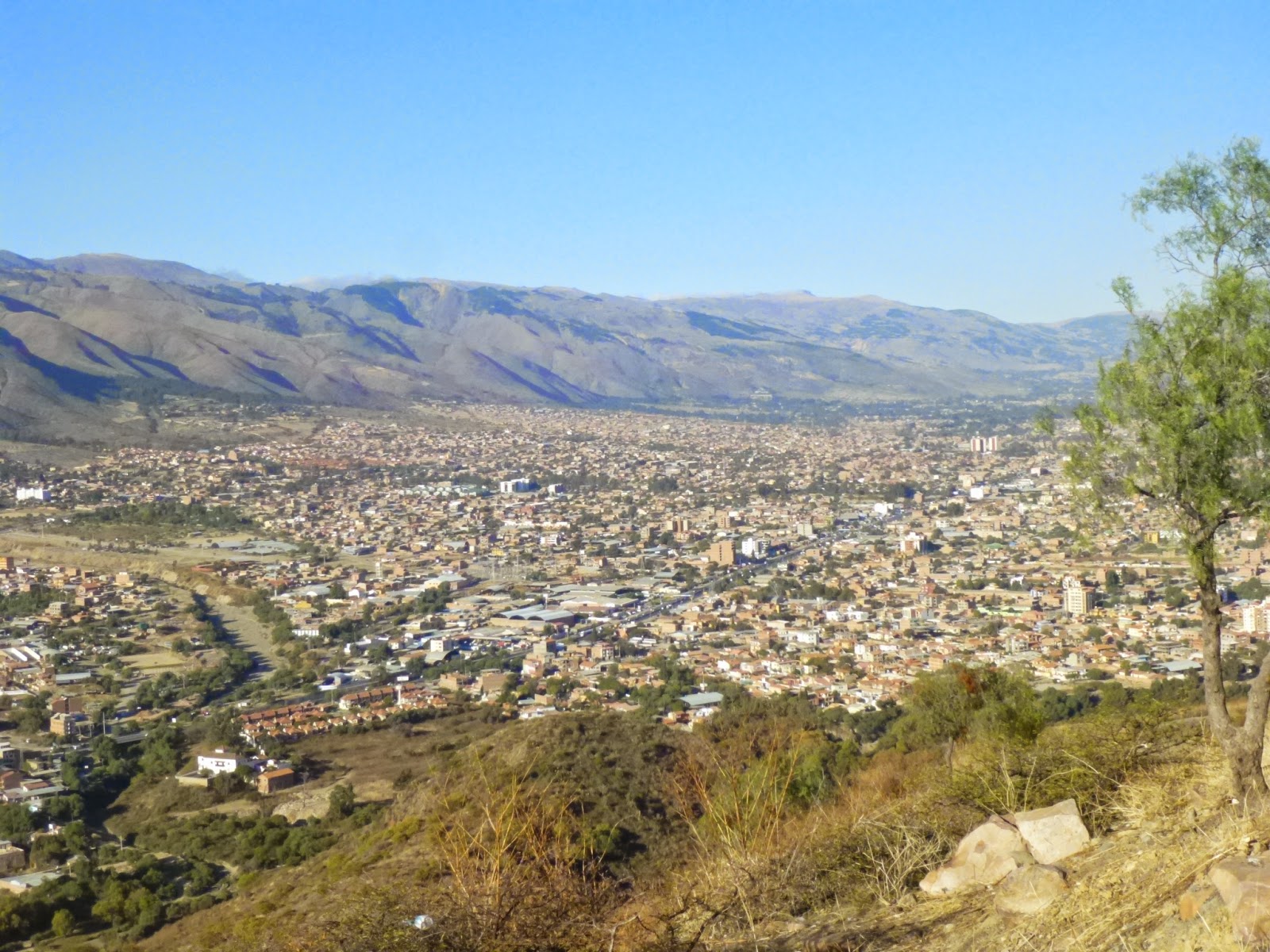The Christus stands at the top of a hill southeast of the temple. The road up to the statue goes way south and then around behind and comes up the back (the east side) the hill. As we were climbing, I got this good shot of Laguna Alalay (Lake Alalay) which is on the south side of Cochamba (and now surrounded by city.)

Here we're on the road up the back side of the hill and to our surprise, we saw this golf course.
Here's a closer look.
I guess there are several golf courses in Cochabamba,
but this is the first one we've ever seen.

Eventually we got to the parking lot.
Elder Westover took this picture of us:
President and Sister Jensen, Farron and me, and Sister Westover.
A van load of Asian youth pulled in beside us and their leader, who is from Korea by way of Virginia (!) took this picture for us. Behind us on the left you can see the steps leading up to the Christus.

This is a closeup of the back of the statue,
taken from the parking lot.
From the parking lot looking east, you can see how the city just goes on and on, as far as you can see.
The church members in this area are in the Sacaba Stake.
It is far enough from the temple that they have to ride 2 different trufis to get there.
This was taken about halfway up the steps to the Christus.
If you note how small the cars in the parking lot appear, you
can guess how high the hill was. I think Farron said it was 150 steps.
As we climbed we were coming up the east side of the hill, which means the temple would have been somewhere to our right and further west. We finally spotted it, although in the haze it was difficult to see. (There is much air pollution in Cochabamba, unfortunately, plus we were looking into the afternoon sun.)

Here's a closeup.
Also behind the statue is a park-like area with benches and a few picnic tables, as well as these two plaques.
This one explains that Cochabamba's Christus is the biggest statue of Christ in the world and it gives all the dimensions. I did the math (aided by Google) and this is how big it is.
The statue itself is 112.4 feet high.
The pedestal is 20.2 feet high.
So the total height is 132.6 feet.
And it weighs - believe it or not - 2,400,000 pounds!!

This one is a tribute to the organization that built (or rather paid for) the statue,
La Asociacion Cristo de la Concordia.
For this reason, the status is actually called Cristo de la Concordia.
It was completed and "dedicated" (if that's the word) in December 1994.
Walking around to the front of the statue, we saw where the trams come up. Here's a picture of Farron at the tram stop. They don't run on Mondays; that's why President drove us up instead of our riding up in one of the gondolas. You are looking west over the downtown area.
Here's a distance shot of the view from the steps in front of the statue.
(The steps lead down to the tram stop, which you can see if you look very closely.)
These are the Asian youth we mentioned who were here in Cochabamba
as 2-week missionaries from the Southern Baptist Convention.
President Jensen took this picture of the Westovers and us.
If you can get your screen big enough to see us and the statue's head at the same time,
you will see how really gigantic this statue is.
As we walked around the back of the statue to leave, Farron and Elder Westover went up to look inside the locked door at the foot of the pedestal. When it's open, you can climb stairs inside to the very top of the statue. However, we have been told it's really, really stinky and dirty inside, so we were not disappointed that it was locked. Of course it was much darker on this side of the statue so you can just barely see the two men at the locked gate.

The statue is very, very impressive - the face is absolutely beautiful - and I'm glad we finally got up there to see it. The 360-degree view is also impressive. (From Wikipedia: Cochabamba is the fourth largest city in Bolivia with approximate population of 1,938,401.) I can believe it's that big. It's a little like being on a hill overlooking any part of Los Angeles -- the city just goes and goes, as far as you can see. One reason it keeps growing (I think) is the wonderful climate. For being at 9,000 feet the weather is remarkably mild. As Wikipedia says, Cochabamba is known as the "City of Eternal Spring" and "The Garden City" due to its spring-like temperatures year round. Compared to how cold the rest of Bolivia is in the winter, it's no wonder people move here. We also know several people who have moved here because they have heart trouble and 9,000 feet is much healthier for them than the 12,000 to 14,000 foot elevation of the other big cities. I don't know if that means our hearts (and lungs) will be stronger by the time we come home to sea level or not; what do you think?
Okay, that's all for today. Until next week, vayan con Dios!














































